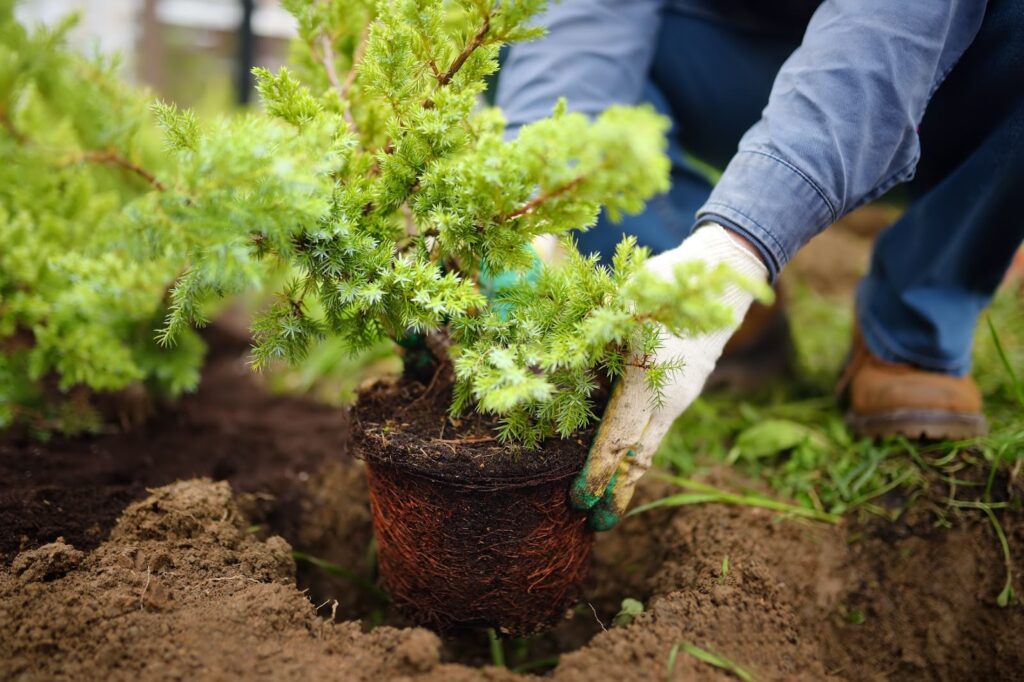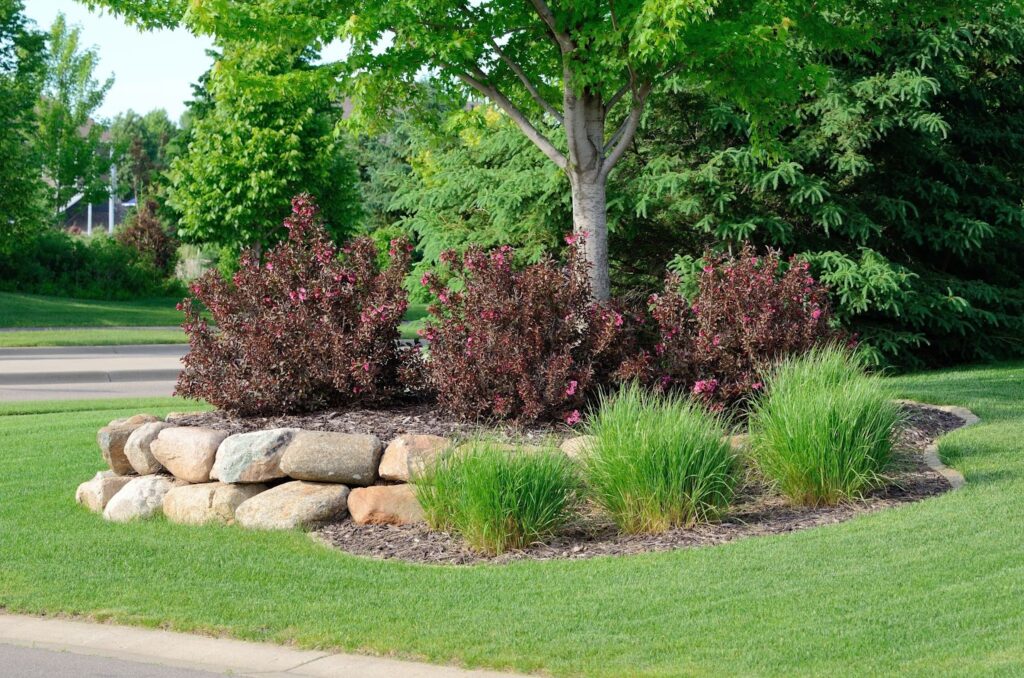Erosion strips away topsoil, weakens structures, and damages landscapes across residential and commercial properties. Rain, wind, and steep slopes speed up this process, creating bare patches, exposed roots, and drainage issues. These problems threaten the long-term health and stability of your landscape.
To combat erosion naturally, use native and hardy plants that grip the soil with deep, fibrous roots. These resilient species adapt to local conditions, thrive with minimal care, and support biodiversity by attracting pollinators and wildlife.
In this blog, you’ll discover the best erosion-controlling plants and learn how to incorporate them into your landscape. We’ll explore top-performing groundcovers, grasses, shrubs, and trees, and provide practical tips to help you protect your property while enhancing its beauty.
Why use plants for erosion control?
Plants create a natural defense against erosion by anchoring the soil with their roots. Deep and fibrous root systems hold soil in place, absorb excess water, and slow down runoff during heavy rains. As roots spread through the ground, they increase soil cohesion and reduce the risk of landslides, washouts, and sediment buildup in nearby waterways.
Beyond preventing erosion, planting native and hardy vegetation benefits the environment. These plants support pollinators, encourage wildlife activity, and enrich the soil with organic matter. As they grow and shed leaves or decompose, they improve soil structure, enhance nutrient cycles, and promote long-term landscape health.
Compared to non-living solutions like retaining walls or synthetic mats, living plant systems offer more flexibility, visual appeal, and ecological value. Retaining walls may block erosion in one area but redirect water to another, while synthetic mats require replacement and provide no additional habitat or soil improvement.
Plants adapt over time, grow stronger with age, and create a thriving landscape that protects your property and benefits the ecosystem.
What to consider when selecting erosion-control plants
Choosing the right plants for erosion control starts with evaluating your landscape’s unique conditions. Steep slopes require species with strong, spreading root systems that hold soil in place and adapt to uneven terrain. On the other hand, gentle slopes support a wider range of grasses, groundcovers, and shrubs.
Pay attention to sun exposure. Areas with full sunlight benefit from drought-tolerant grasses and native wildflowers, while shady zones thrive with shade-loving groundcovers and ferns. Soil type also matters — sandy soils drain quickly and need moisture-retaining plants, while clay soils call for species that tolerate dense, compacted ground.
Consider your regional climate. Native plants perform best because they evolved to survive local weather patterns, soil conditions, and pests. These plants require less water, fewer inputs, and provide critical support for pollinators and wildlife.
In contrast, non-native species often struggle with extremes in temperature, rainfall, or soil structure, making them less effective for long-term erosion control.
Layering your plant selections strengthens erosion resistance. Combine deep-rooted trees or shrubs with medium-rooted perennials and shallow-rooted groundcovers. This diversity stabilizes the surface but also reinforces soil at multiple depths, improving structure and drainage.
A well-planned mix of plant types creates a resilient, self-sustaining system that reduces runoff, prevents washouts, and enhances landscape beauty.

10 best plants for erosion control
Integrating the right plants into your landscape helps control erosion naturally while adding beauty and texture. These ten species offer strong root systems, adaptability, and visual appeal across a range of environments.
Switchgrass (Panicum virgatum)
Switchgrass thrives in full sun and tolerates various soil types, including clay and sandy loam. Its deep, fibrous roots stabilize slopes and effectively absorb runoff. This native ornamental grass also provides year-round interest and shelter for birds and beneficial insects.
Creeping Juniper (Juniperus horizontalis)
Creeping Juniper spreads low and wide, forming a dense, evergreen carpet across dry, sunny slopes. Its fibrous roots cling to shallow soil, making it ideal for erosion-prone hillsides. The foliage adds evergreen color, and its drought tolerance reduces the need for irrigation.
Red Osier Dogwood (Cornus sericea)
Red Osier Dogwood flourishes near water sources and in wet, poorly drained soils. Its extensive root network holds streambanks and riparian zones together, preventing washouts. In addition to stabilizing soil, its red stems add winter interest, and its flowers attract pollinators in spring.
Prairie Dropseed (Sporobolus heterolepis)
Prairie Dropseed adapts well to dry, sunny locations. It features a fine-textured form and deep root system that improves soil structure. This ornamental grass resists drought, enhances slope stability, and offers a soft, flowing look that complements native plantings.
Daylilies (Hemerocallis spp.)
Daylilies grow quickly and tolerate a range of soil and sun conditions. Their thick, fibrous roots hold soil in place and spread efficiently across garden beds or slopes. Their vibrant blooms provide seasonal color, and their foliage suppresses weeds and shades the ground.
California Lilac (Ceanothus spp.)
California Lilac grows best in sunny, well-drained locations. This evergreen shrub thrives on dry slopes where it forms a bushy, erosion-resistant barrier. Its nitrogen-fixing roots improve soil health, and its blue flowers attract pollinators and add springtime color.
Sedum (Sedum spp.)
Sedum suits rocky or nutrient-poor soils, especially on dry slopes or green roofs. Its succulent leaves store moisture, while its shallow roots spread quickly across the soil surface. Sedum resists erosion in harsh conditions and offers low-maintenance color with seasonal blooms.
Willow (Salix spp.)
Willow trees prefer wet areas like streambanks, ditches, and lowlands. Their fast growth and aggressive roots help anchor shifting soil and absorb excess water. Willows improve drainage and support wildlife, making them ideal for controlling erosion in flood-prone locations.
Sedges (Carex spp.)
Sedges perform well in moisture-rich environments, especially where other grasses may struggle. Their dense root mats grip soil firmly and improve filtration along water edges. These versatile, grass-like plants support biodiversity and adapt to both sun and shade.
Sumac (Rhus spp.)
Sumac grows rapidly on sunny slopes and disturbed ground. It spreads through underground rhizomes, creating a dense thicket that stabilizes loose soil. Its bold foliage turns brilliant red in fall, and its berries feed birds and other wildlife through winter.
By combining these resilient plants across your landscape, you improve erosion control naturally while enhancing texture, color, and habitat value. Each species contributes uniquely to soil stability, helping you build a stronger, more sustainable outdoor space.
Design strategies for planting
Strategic planting improves erosion control while adding structure and beauty to your landscape. Grouping and layering plants increases soil coverage, protects against runoff, and encourages healthier growth across various slopes and terrain types.
Layer plants
Start by layering plants with different heights and root depths. Position taller shrubs and trees toward the back or top of slopes, where their deeper roots provide strong anchoring. Use mid-sized perennials and grasses in the middle zones to create a transition.
Plant groundcovers
Plant low-growing groundcovers at the front or base to blanket exposed soil and reduce erosion from rainfall or wind. This layering system helps slow water movement and maximizes root reinforcement throughout the area.
Maintain proper spacing
Maintain proper spacing to allow each plant to establish strong roots and mature without overcrowding. Choose companion plants that thrive in the same light and soil conditions.
For example, pair drought-tolerant grasses with sun-loving perennials or moisture-loving sedges with native ferns in shaded areas. These combinations promote balanced growth, reduce competition, and support diverse ecosystems.
Cover exposed soil
Cover any exposed soil with mulch or fast-spreading groundcover species. Organic mulch such as shredded bark, straw, or compost regulates moisture, enriches the soil, and prevents erosion between plantings. Groundcovers like creeping thyme or sedum spread quickly, locking soil in place while adding texture and seasonal interest.
Maintenance tips for erosion-control plantings
Keeping erosion-control plantings healthy requires consistent maintenance, especially during the early stages of growth. With the right care, your landscape will stay resilient and continue to prevent soil loss effectively.
Water new plants
Water new plantings deeply and regularly during the first growing season. Focus on slow, thorough watering that encourages deep root development rather than frequent shallow watering.
Once the plants establish strong root systems, gradually reduce irrigation frequency. Native and drought-tolerant species often need minimal supplemental water after establishment, making them ideal for long-term sustainability.
Prune plants
Prune your plants seasonally to encourage healthy growth and maintain their shape. Remove any dead, damaged, or diseased branches in late winter or early spring before new growth appears. Trim overgrown groundcovers and shrubs in midsummer to prevent them from smothering neighboring plants or leaving areas exposed to erosion.
Inspect your landscape
Stay vigilant about invasive species and aggressive spreaders that compete with your erosion-control plants. Regularly inspect your landscape for fast-spreading weeds or non-native plants. Pull or dig out any intruders promptly, and replant bare patches to restore ground cover. Use mulch or dense plantings to limit open soil and discourage weed growth.
When to seek professional help
Some erosion challenges require more than DIY solutions, especially when dealing with steep grades, unstable slopes, or recurring drainage issues. In these situations, a professional brings the expertise needed to stabilize the terrain and protect your property.
If your yard includes sharp inclines, visible soil movement, or signs of slope failure, consult a landscape professional. They assess the severity of the erosion, examine water flow patterns, and identify risks that may not be visible to the untrained eye. Their evaluation leads to informed recommendations that align with your property’s unique conditions.
In many cases, effective erosion control involves more than planting alone. Professionals often integrate planting with structural solutions such as retaining walls, terraces, or swales to redirect water and reduce runoff. They also adjust grading to improve drainage and prevent pooling, which can erode soil and stress plants.
When erosion becomes complex or threatens your landscape’s stability, bring in a trusted landscaping team. Their knowledge and experience provide peace of mind and ensure your outdoor space remains both beautiful and secure.

Lasting results with LaytonScape
LaytonScape specializes in erosion-control solutions tailored to your property’s unique conditions. From selecting the right plants to integrating grading and drainage strategies, their team delivers thoughtful, high-impact landscaping that keeps your outdoor space secure and stunning season after season.
Contact LaytonScape today to start building a stronger, more sustainable landscape.

